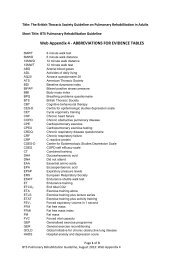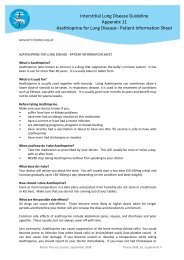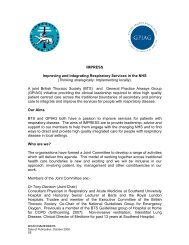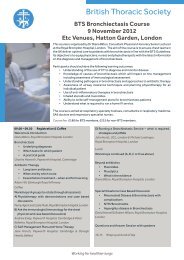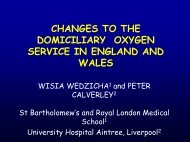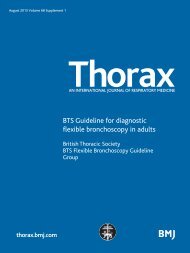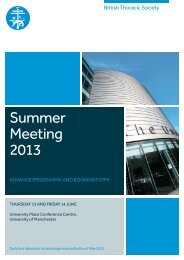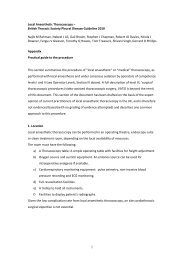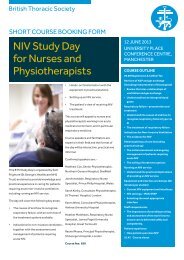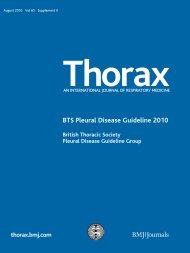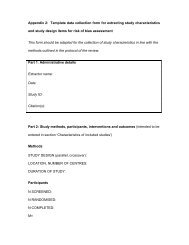Guidelines for the management of community ... - Brit Thoracic
Guidelines for the management of community ... - Brit Thoracic
Guidelines for the management of community ... - Brit Thoracic
Create successful ePaper yourself
Turn your PDF publications into a flip-book with our unique Google optimized e-Paper software.
Contents Volume 64 Issue Suppl III | THORAX October 2009<br />
6.3 What predictive models <strong>for</strong> assessing<br />
severity on or shortly after hospital<br />
admission have been tested?<br />
6.4 What severity assessment strategy is<br />
recommended <strong>for</strong> CAP?<br />
6.5 Severity assessment <strong>of</strong> CAP in patients<br />
seen in <strong>the</strong> <strong>community</strong><br />
6.6 Severity assessment <strong>of</strong> CAP in patients<br />
seen in hospital<br />
6.7 Reviewing severity status after initial<br />
assessment in hospital<br />
iii28 Section 7 General <strong>management</strong> in<br />
<strong>the</strong> <strong>community</strong> and in hospital<br />
7.1 What general <strong>management</strong> strategy<br />
should be <strong>of</strong>fered to patients treated in<br />
<strong>the</strong> <strong>community</strong>?<br />
7.2 What review policy should be adopted in<br />
patients managed in <strong>the</strong> <strong>community</strong>?<br />
7.3 What general <strong>management</strong> strategy<br />
should be <strong>of</strong>fered to patients in hospital?<br />
7.4 What advice should be given regarding<br />
critical care <strong>management</strong> <strong>of</strong> CAP?<br />
7.5 What arrangements should be made <strong>for</strong><br />
follow-up after hospital discharge and by<br />
whom?<br />
iii32 Section 8 Antibiotic <strong>management</strong><br />
8.1 Introduction<br />
8.2 Antibiotic stewardship and <strong>the</strong> individual<br />
clinician’s responsibility to prevent <strong>the</strong><br />
overuse <strong>of</strong> antibiotics when managing CAP<br />
8.3 Antibiotic resistance <strong>of</strong> respiratory<br />
pathogens<br />
8.4 Newer antibiotics<br />
8.5 Clinical studies <strong>of</strong> <strong>management</strong> and<br />
international differences in<br />
recommendations<br />
8.6 Formulations <strong>of</strong> <strong>the</strong>se recommendations<br />
8.7 Empirical antibiotic choice <strong>for</strong> CAP<br />
treated in <strong>the</strong> <strong>community</strong><br />
8.8 Should general practitioners administer<br />
antibiotics prior to hospital transfer in<br />
those patients who need admission?<br />
8.9 When should <strong>the</strong> first dose <strong>of</strong> antibiotics<br />
be given to patients admitted to hospital<br />
with CAP?<br />
8.10 Empirical antibiotic choice <strong>for</strong> adults<br />
hospitalised with low severity CAP<br />
8.11 Empirical antibiotic choice <strong>for</strong> adults<br />
hospitalised with moderate severity CAP<br />
8.12 Empirical antibiotic choice <strong>for</strong> adults<br />
hospitalised with high severity CAP<br />
8.13 When should <strong>the</strong> intravenous or <strong>the</strong> oral<br />
route be chosen?<br />
8.14 When should <strong>the</strong> intravenous route be<br />
changed to oral?<br />
8.15 Which oral antibiotics are recommended<br />
on completion <strong>of</strong> intravenous <strong>the</strong>rapy?<br />
8.16 How long should antibiotics be given <strong>for</strong>?<br />
8.17 Failure <strong>of</strong> initial empirical <strong>the</strong>rapy<br />
8.18 Antibiotic stewardship and avoiding<br />
inappropriate antibiotic prescribing <strong>for</strong> CAP<br />
8.19 What are <strong>the</strong> optimum antibiotic choices<br />
when specific pathogens have been<br />
identified?<br />
8.20 Specific issues regarding <strong>the</strong><br />
<strong>management</strong> <strong>of</strong> Legionnaires’ disease<br />
8.21 Specific issues regarding Panton-<br />
Valentine Leukocidin-producing<br />
Staphylococcus aureus<br />
iii43 Section 9 Complications and<br />
failure to improve<br />
9.1 What factors and action should be<br />
considered in patients who fail to<br />
improve in hospital?<br />
9.2 What are <strong>the</strong> common complications <strong>of</strong><br />
CAP?<br />
iii44 Section 10 Prevention and<br />
vaccination<br />
10.1 Influenza and pneumococcal vaccination<br />
10.2 Smoking cessation<br />
iii44 Section 11 Committee membership<br />
and acknowledgements<br />
11.1 Membership <strong>of</strong> <strong>the</strong> BTS Community<br />
Acquired Pneumonia <strong>Guidelines</strong><br />
Committee and affiliations<br />
11.2 Authorship <strong>of</strong> sections <strong>of</strong> <strong>the</strong> guidelines<br />
11.3 Acknowledgements<br />
11.4 Declarations <strong>of</strong> interest<br />
iii45 References<br />
iii54 Appendix 1 Checklist used by<br />
reviewers <strong>for</strong> appraising studies<br />
iii54 Appendix 2 Additional checklist<br />
used <strong>for</strong> appraising studies to<br />
in<strong>for</strong>m pneumonia aetiology<br />
iii55 Appendix 3 Types <strong>of</strong> study and<br />
levels <strong>of</strong> evidence used to illuminate<br />
specific clinical questions<br />
iii55 Appendix 4 Generic levels <strong>of</strong><br />
evidence and guideline statement<br />
grades, appropriate across all<br />
types <strong>of</strong> clinical questions



